Jules Has Coffee With Jim Averbeck
Except If She’s Swamped and Ms. Jessica
Wiggebotham-Whyte Pours the Coffee Instead
 April 25th, 2011 by jules
April 25th, 2011 by jules
When you’re super swamped and have your own writing deadlines and a whole host of other stuff to do, yet you see a picture book like Jim Averbeck’s Except If, released by Atheneum in January of this year, and you really super bad want to feature the book, what do you do? Well, you could email the author/illustrator and tell him exactly how super swamped you are but that you’d love for him to send an in-his-own-words type of feature about the book, along with some art, if he’s so inclined to oblige. So, that’s what I did in this instance. And when you give someone like Mr. Averbeck the freedom to just run with it? Well, you’re in for some fun.
You see, Jim has this very close friend. Her name is Jessica, and she’ll introduce herself in just a moment. Since I was so swamped when this book was first released (yes, this was over three months ago—and I’ve also been sitting on this post about a month now—so I’m happy to finally be bringing it to readers), Jim invited Jessica over to interview him in my stead. I was happy to turn the breakfast table over to her. As you can see below, she has a very festive scarf, for one, which I may beg to borrow. Also her full name is just a KICK to say.
If you haven’t seen Except If yet, know that it’s been described as no less than a “short, sweet, philosophical speculation” (Publishers Weekly), an “existential” and “deceptively simple yet delightful tale” (Kirkus), and “contrarian” fun (Booklist). The book starts with an egg, which is not what you think. It’s not a baby bird, you see, “but it will become one except if it becomes a baby snake.” Readers’ expectations continue to be overturned with successive page turns—and the repeated use of “except if”—in this puzzler of a book, less of a story than a “convergence of fanciful possibilities,” as School Library Journal wrote. Just when readers think the story is going one way, Averbeck provides a narrative detour. Adds the PW review, “{e}ven very young readers will find they’ve succeeded in following a rather convoluted piece of reasoning, clause by clause and picture by picture; it’s a book in which the action unfolds in the mind as much as it does on the page.” I don’t want to give it all away either and spoil your experience reading it, if you haven’t already, but let’s just say it ends as it started — with a pale blue egg and maybe, just maybe, a baby bird.
Okay. Back to work. Jessica’s here to take over—she’s already brewed the coffee—and I thank her. And Jim. For running with it. No except-ifs about that one.
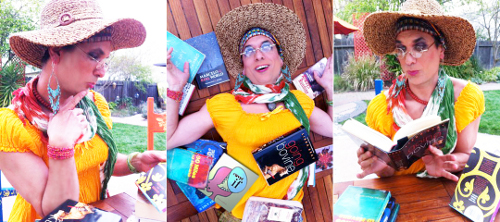
Guest Interviewer: Jessica Wiggebotham-Whyte, MLIS
Jessica Wiggebotham-Whyte is an ardent admirer of children’s literature. A recent(ish) graduate from the Grenada School of Information Sciences, she is currently shoring up the children’s collection at the Emma Woodhouse School for Young Ladies in Austen, Texas. She is the author of Pulling Max’s Tail: An Irreverent Look at Classic Picture Books and Edgy-Schmedgy: A Compendium of Banned Books Every Teen Should Own. She reads at home with her husband, Jeroboam, and their cat, Mick Jagger III.
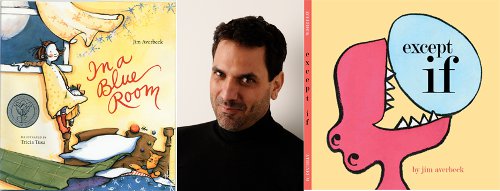
Our guest for breakfast today:
Author/Illustrator Jim Averbeck
Jim Averbeck is the author of the critically-acclaimed Except If and winner of a Charlotte Zolotow Honor for his first book, In a Blue Room. He lives in San Francisco with his partner and their dog. He can be found online at JimAverbeck.com and TheRevisionaries.com.
Jessica: Hello, dear readers. I’m filling in today for Jules, and I’m so fortunate to get to interview one of my favorite children’s book authors, Jim Averbeck. Welcome, Jim.
Jim: Hi, Jessica. Nice to be here.
Jessica: My first-graders at EWSYL just love your book. What was the genesis of Except If?
Jim: I’m a member of a group of children’s book writers called “The Revisionaries.” We meet throughout the year to critique each other’s work, striving to create new classics of children’s literature. (Well, you gotta have high goals, right?) You’ve probably heard that E.B. White said “the best writing is rewriting.” That’s why we named our group as we did, because we wanted to always have it in our minds that revision is where real writing takes place.
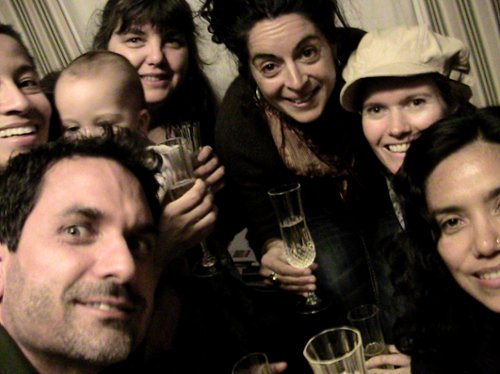
But for our holiday meeting in December, we all participate in “The Assignment.” The idea is to put aside all revision and start something new. We come up with a vague theme or writing prompt, and everyone uses that as a springboard for a new story. The themes are sometimes a bit odd. Here are a few from the past:
- The Lost Thing
- The Hideous Thing
- The Hidden Thing
- I Had a Bucket of Paint and I Was Mad
- The Scratchy Noise from My Underpants Drawer
- It Came in on My Shoe
In December 2008, I sat down a day before the holiday meeting. The assignment was “Baby Book,” which meant it could be a story for babies or about babies or about something baby-like or about a book that was a baby, etc. Of course, I didn’t want to just write a book with a baby as the main character. Too predictable. So, I sat down and thought, “what is like a baby, but not?” My answer was “an egg.” I said to myself, “an egg is not a baby bird.” Immediately after, it occurred to me that that statement sounded a bit like a pro-choice slogan, and I wondered what the pro-life response would be. “But it will become one” sprang to my mind. And there I had the first two lines of my story.
But an egg becoming a bird seemed a bit expected, so I asked myself what I could do that would be unexpected. I sketched the egg and stared at it for a while, and I remembered finding the remains of box turtle eggs when I was a kid. What if the egg hatched something else? This opened a lot of possibilities -– snakes, lizards, turtles, etc. So, I repeated the first two lines and tried to figure how to get to snakes.
An egg is not a baby bird, but it will become one _____ a baby snake.
The obvious fill-in-the-blank was “except if it becomes” a baby snake. And I knew that the words “except if” could come before the page turn and be used throughout the book as a cue to kids that a surprise would arrive on the next page. As it ends up, I’ve had many positive reviews that mention the strong central concept of the book is great for classroom activities around challenging assumptions and using your imagination.
Jessica: Except If is one, in fact, one long run-on sentence. That was a grammatically daring choice. Why did you make it?
Jim: I thought about how conversations with young children often go. They hitch one thought on the back of another unendingly, like a train with no caboose. I wanted to capture that sort of mental process. So, I decided to see if I could make a story out of one long run-on sentence with a surprise after each turn of the page — and the words “except if” connecting the whole thing together. Of course, I had to create a caboose, because a picture book has a finite number of pages. I thought about a lecture I once heard by Richard Peck, where he stated “the beginning is the end in disguise” and the lectures I myself had given on circular story structure. It seemed to me that a circular ending was perfect if I was trying to imitate a child’s thought patterns, because a circle gives closure but also implies a sort of infinite loop. So, now I had the beginning of my story, the end, and concept of how to get from here to there.
Jessica: My own scholarly volumes took several years each to write. It made me wonder, how long does it take to write a one-sentence picture book?
Jim: Often months and months. In this case, I had about two hours to write it, because The Revisionaries were meeting the next day. So, I wrote and, because the story depends so much on visual transitions and surprises, I sketched out some very quick drawings on my computer. Because I was working so fast, the sketches had a very child-like quality.
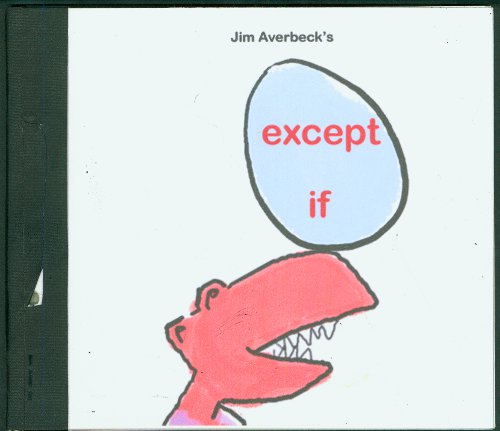
The next day, I showed it to my critique group and, for only the second time in their ten-year history, the group said “submit it, don’t change a thing.” I did, in fact, spend a couple of weeks revising and polishing it before I sent it in, but Except If was conceived at the end of December 2008, submitted in January 2009, acquired in a two-book deal in February 2009, and published in January 2011. So, a little over two years from idea to bookstore. That’s sort of a minor miracle in the picture book world.
That year’s “assignment” was a good one for The Revisionaries. Four of the six of us sold the books we wrote for it. And I wouldn’t doubt that the other two might as well.
Jessica: The editor on my current tome keeps changing the title. What were some of the changes you made?
Jim: Originally, the lizard grew into a dinosaur who stood taller than the trees, but then the “trees” were just twigs on the end of a branch, and the dino was just a lizard after all. The issue with this was that it required the narrative to go backwards a bit. Essentially, I lied and broke trust with the reader by saying the lizard was a dino — and then saying it wasn’t.
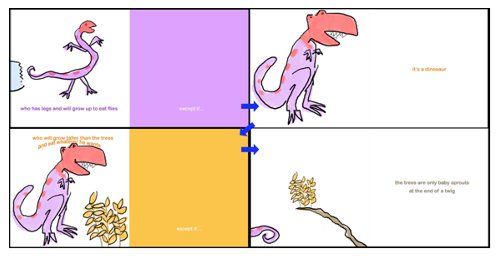
Then for a while the lizard grew into an alligator, who drifted in the water, but then was actually a branch drifting in the water, which then was actually attached to a tree. Developmentally, picture-book-age children tend to have a pretty linear viewpoint of things, and this solution was even more non-linear than the lizard-dino-lizard narrative. Eventually, I hit on the fossil solution you see in the finished book. All this was done before submission. The text I submitted remained pretty much unchanged.
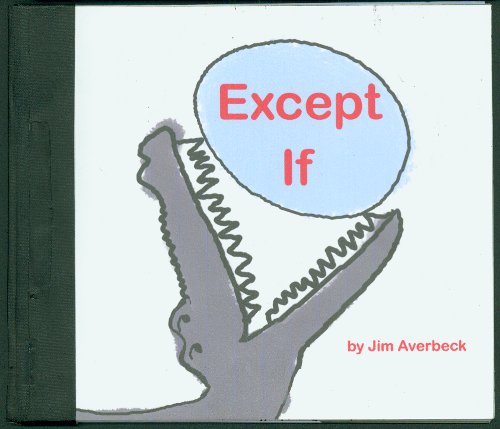
The illustrations, however, did change quite a bit. Originally, the story had a “color concept book” aspect to it. As each thing was revealed, it had a different color from the thing before it. So, a blue egg hatched a red snake, who ended up being a purple lizard with a red head, who was taller than the green trees, etc. The “except if” page of each spread was a solid block of the new color. But in the end, the editor, art director, and I decided the color concept was a distraction from the strong central idea of challenging assumptions. And I added a ground line that broke the color blocks in an odd way. So, we dropped the whole color concept aspect.
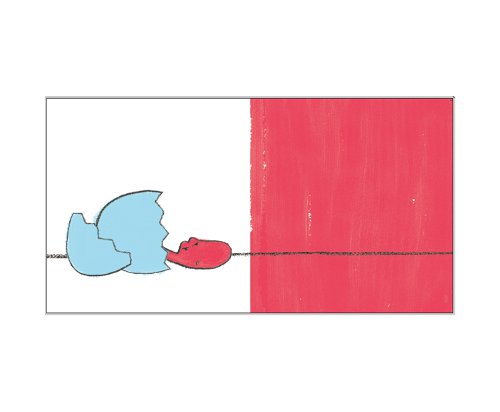
See how adding the ground line makes the color block confusing. Is the ground red or white? It didn’t make sense.
I liked the scratchy, child-like quality of the line from my quick sketches. So, I tried to retain that as I refined the images. But it is very difficult to draw like a child. My style up to this point was a bit more sophisticated.
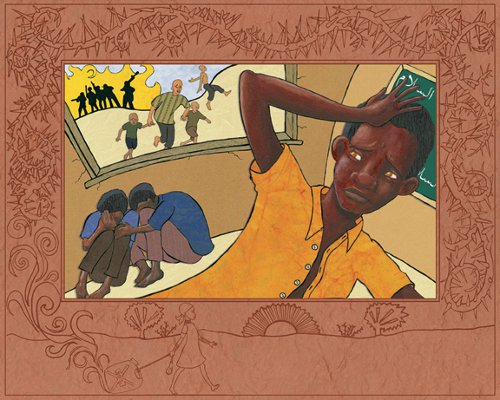
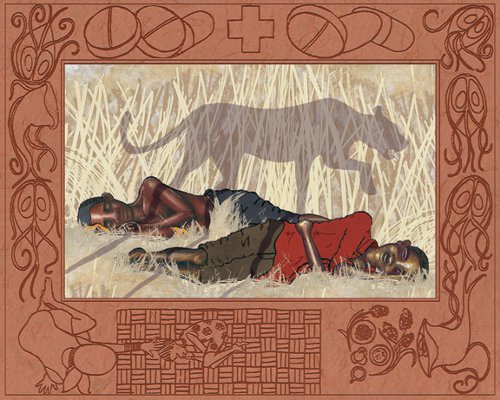
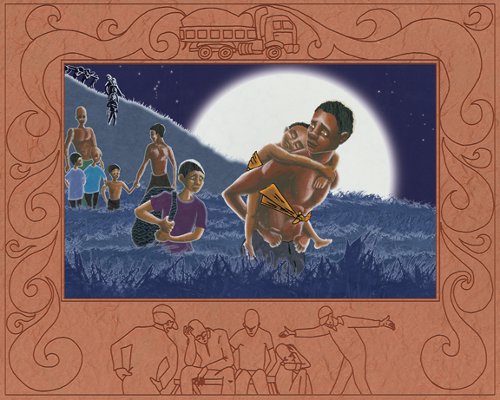
a novel serialized in newspapers and online
To achieve the child-like quality I wanted, I printed—in blue—many copies of the image on textured paper. Then I traced it over and over as quickly as possible with a black oil pastel (essentially, a fancy version of a child’s favorite art tool – the crayon.) Then I chose the drawing that had that loose sketchy quality I wanted and scanned it into the computer. Deleting the blue-lined guide left me with a black outline. These I printed on watercolor paper and painted with watercolors.
(Click to enlarge)
Jessica: You said this was part of a two-book deal. What can you tell us (or show us) about the second book?
Jim: When the deal was struck, I had no idea what the second book would be. I had planned a trip to China — to study Chinese art and research pandas for another book I am writing. Our guide in Beijing told us his name was “Frank.” When I asked him for his Chinese name, he said “Xiao Loong” which means “Little Dragon.” I thought, Little Dragon? That is a picture book character for sure! I spent a lot of time on that trip writing the story that became the second book, currently titled Oh No, Little Dragon! It’s about a flame-proud dragon who takes a bath and puts out his fire. Here are a couple of images:
(Click to enlarge spread)
(Click to enlarge)
Thank you for including this in the interview, so the IRS will not doubt my deductions from the year of that China trip!
Jessica: It’s been such a pleasure to meet you. Is there anything else you’d like to add?
Jim: Just say ‘hi’ to Jules — and thanks for letting me stop by to chat here at 7 Impossible Things. And good luck to both of you on the books you are writing. And you know, if you aren’t doing anything later….call me.
EXCEPT IF. Text copyright © 2011 by Jim Averbeck. Published by Atheneum Books for Young Readers, New York, Boston. All images reproduced by permission of the illustrator.
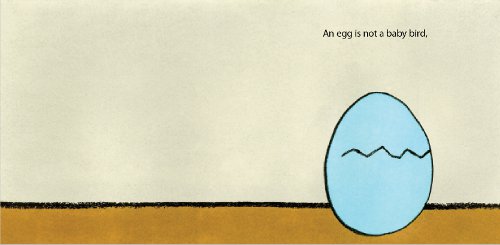
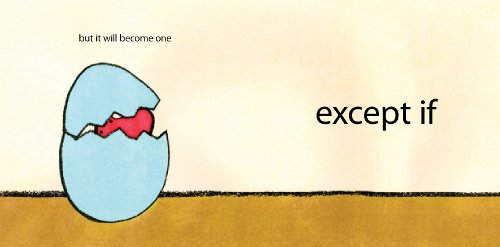
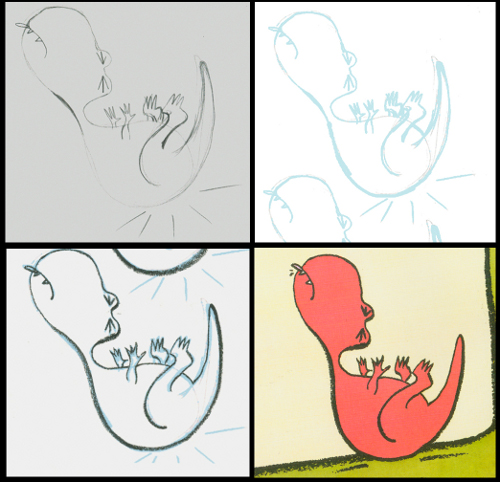
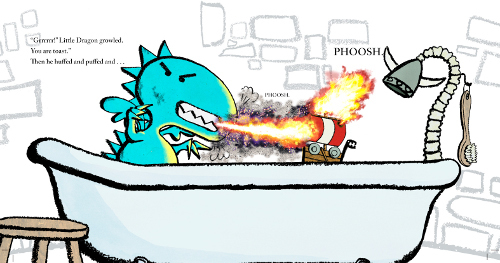
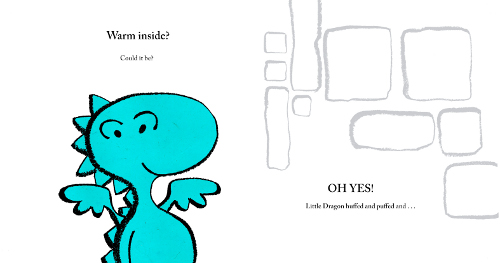

So great to take a look at his process, from idea through the revisions to the final product. I really like seeing the way the images were created, as I often wonder how illustrators retain that beautiful sketchy quality that I love through the various phases of manipulating the image.
I also love the idea of kids hitching thoughts together in an unending sequence like a train with no caboose. Mine do it all the time with “and then” as they tell stories. I could see how “except if” would make for exciting page-turns and hypotheses about what comes next.
Thanks to Jessica for this great interview. (And I love her earrings!)
Hi Jules,
You’ll have to borrow the scarf from Yuyi Morales. Jessica borrowed it from her – and the earrings too!
Thanks for giving me an opportunity to stop by for breaky.
AWESOME interview! I adore Jim and his books! Can’t wait to get my hands on a copy of EXCEPT IF. (Thanks for reminding me)!) Loved seeing it as an F&G! Congratulations!
I heart Jessica Wiggebotham-Whyte’s entire outfit. And, her dimples…
I like seeing how this came together – I think the non-specific dinosaur works perfectly. It amazes me how artists work, and I’m intrigued every single time they show the steps of how things come together. And the premise of the book is exactly how my nephews thing and tell their very long stories.
Y’all. I’ll still trying to decide which is my favorite: I Had a Bucket of Paint and I Was Mad; The Scratchy Noise from My Underpants Drawer; or It Came in on My Shoe. I mean, seriously. I think I snort-laughed when I read that.
[…] to 7-Imp by “Guest Interviewer” Jessica Wiggebotham-Whyte, MLIS, pictured above, on April 25, 2011: “I thought about how conversations with young children often go. They hitch one thought on […]